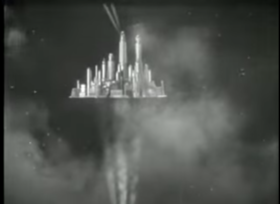@Nablai's Nebula
In this latest issue of Tevun-Krus, we'll be talking everything Sky-Punk.
SkyPunk is defined as the Punk that mostly takes place in the sky, aerial view, via planes, blimps, floating island... anything involving being in above grounds.
We've spend a fair amount of time in the oceans and on land. Resulting in depleting our natural resources. Scientists have found people like living on the upper floors or on top of the hills. There are many people who given a chance, would love to live on the ocean depths or will live on the North Pole. This means if the concept of cities floating in the sky does become a reality in the near future, we would would probably get a fair number of folks ready to live there.While very large floating structures have been constructed or proposed in real life, aerial cities and islands remain in the realm of fiction.
In speculative fiction, floating cities and islands are a common trope, which range from cities and islands that float on water to ones that float in the atmosphere of a planet by scientific or magical means.

SkyPunk was depicted as early as 1726 by Jonathan Swift in his novel Gulliver's Travels. He portrayed Laputa, an island city that floated in the sky which was purportedly levitated through use of artificial magnetism. The concept of a floating city was intended to satirize far-fetched pseudo-scientific reports.
During the 1920's, sci-fic author Hugo Gernsback theorized about floating cities of the future, suggesting that 10,000 years in the future "the city the size of New York will float several miles above the surface of the earth, where the air is cleaner, purer and free from disease carrying bacteria." To stay in the air, four gigantic generators will shoot earthward electric rays which by reaction with the earth produce the force to keep the city aloft.
In 1960, the architects Buckminster Fuller and Shoji Sadao proposed the construction of a 1-mile-diameter (1.6 km) thermal airship, which they called Cloud Nine. This mega-structure would be a geodesic sphere that, once it was sufficiently heated by sunlight, would become airborne. Fuller and Sadao envisioned that Cloud Nine would float freely in the Earth's atmosphere, giving residents and passengers a migratory lifestyle. They believed it might be a likely solution to the depletion of non-renewable resources on earth.
The "Triton City" was the work of the Triton Foundation whose principal members were Buckminster Fuller and Shoji Sadao. It was commissioned by HUD- a federal agency by its director, Charles Haar, to design a floating city to provide housing in urban areas located near the ocean.
A tetrahedron shaped module holding 5,000 inhabitants was designed and a comprehensive engineering report was submitted together with a large model which is on display in the lobby of the Lyndon B. Johnson Center in Austin, Texas.
A design similar to Fuller's Cloud Nine might permit habitation in the upper atmosphere of Venus, where at ground level the temperature is too high and the atmospheric pressure too great. As proposed by Geoffrey A. Landis, other than Earth, to place floating cities at this point would appear to be Venus.
It's thick carbon dioxide atmosphere is 50% denser than air. Breathable air (21:79 Oxygen-Nitrogen mixture) is a lifting gas in the dense Venerean atmosphere, with over 60% of the lifting power that helium has on Earth. In effect, a balloon full of human-breathable air would sustain itself and extra weight (such as a colony) in midair. This means that any large structure filled with air would float on the carbon dioxide, with the air's natural buoyancy counteracting the weight of the structure itself.
At an altitude of 50 km above the Venerean surface, the environment with a pressure of approximately 1 bar and temperatures in the 0°C-50°C range. The fact there is no significant pressure difference between the inside and the outside of the breathable-air balloon, any rips or tears would cause gases to diffuse at normal atmospheric mixing rates, giving time to repair any such damage. In addition, humans would not require pressurized suits when outside, merely air to breathe and a protection from the acidic rain.
Since such colonies would be viable in current Venerean conditions, this allows a dynamic approach to colonization instead of requiring extensive terraforming measures in advance. The main challenge would be using a substance resistant to sulfuric acid to serve as the structure's outer layer. Ceramics or metal sulfates could possibly serve in this role.
In science-fiction, floating cities can be envisioned in the outer three gas planets (Saturn, Uranus, and Neptune) as the gas giant like Jupiter lack solid surfaces. The Jupitarian atmosphere isn't viable for habitation due to its high gravity, escape velocity and radiation.
That's it, folks. We'll meet again next month with another interesting article. Stay tuned for updates.
Bạn đang đọc truyện trên: AzTruyen.Top